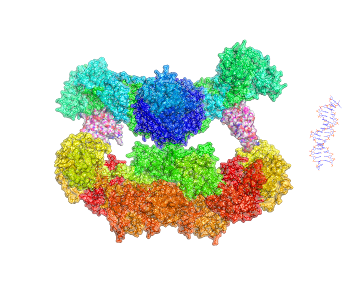Small molecule biosynthesis
Below is an image of the structure of a fatty acid synthase (FAS). The FAS is
a simple example of a type I polyketide synthase that produces fatty acids by the
iterative action of the 'modules' from which the FAS is composed. Some modules act
as scaffolding that holds the growing molecule and positioning it so that other modules
may catalyze the addition or modification of functional groups. The FAS is a good model
for visualizing how polyketide and non-ribosomal peptide synthases are structured.

Fig 1. FAS crystal structure. The space-filling colors correspond to the class of module
(e.g. the pair of brain-colored modules are acyl carrier proteins). DNA for scale.
Made in pymol using pdb: 2VZ9 and 2JU2 (FAS) and 30S0 (DNA fragment)
Some examples of PKS modules can be found in the table below.
Table 1. Selection of PKS modules
| Acronym
| Name
| Function
|
| ACP
| Acyl carrier protein
| Holds growing molecule via thioether, related to peptidyl carrier protein found in non-ribosomal peptide synthases.
|
| AT
| Acyl transeferase
| Catalyzes transfer of acyl groups, forming either esters or amides. Supplies 'extender units' like malonyl.
|
| KS
| Keto synthase
| Performs Claisen-type chain elongation using the growing chain supplied by ACP and extender from AT.
|
| DH
| Dehydratase
| Forms double or triple bonds via removal of water.
|
| MT
| Methyltransferase
| Catalyzes addition of methyl groups.
|
Relevant Review Articles
If you are interested in learning more about this topic, check out the following:
- The evolution of gene collectives: How natural selection drives chemical innovation
Michael Fischbach, Christopher Walsh, and Jon Clardy
PNAS website
PDF link
- Polyketide synthases and nonribosomal peptide synthetases: the emerging view from bacterial genomics
Stefano Donadio, Paolo Monciardinia, and Margherita Sosioa
Nat. Prod. Rep. website
PDF link
Return to Nick's home page
